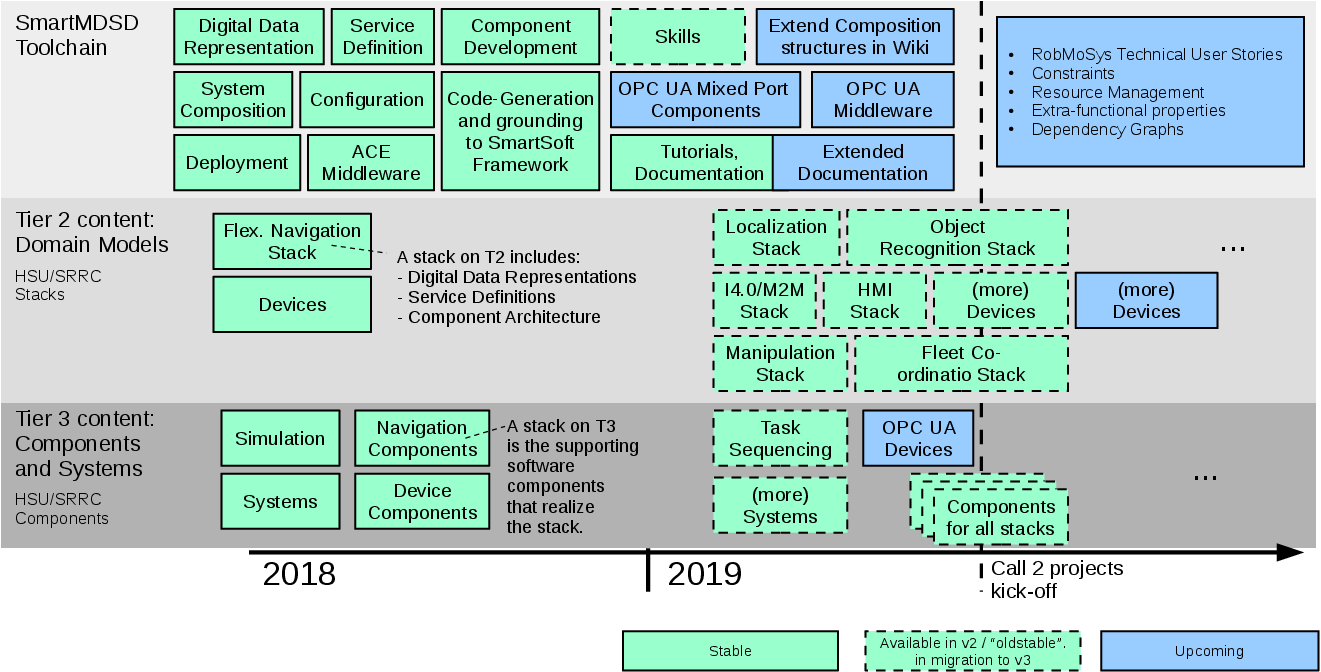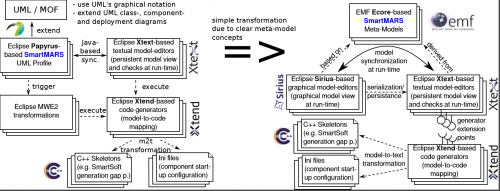Table of Contents
SmartMDSD Toolchain Roadmap
The SmartMDSD Toolchain in its current version 3 (v3) is stable and is recommended to use if you begin using the SmartMDSD Toolchain. It was first released stable in March 2018.
This page is as of December 2018
Current State
The SmartMDSD Toolchain v3 is stable and is ready to use to build components and systems.
- Creation of domain models
- Development of software components
- Composition of software components to systems
- Configuration of component-related and system-related properties
- Deployment and execution of software components
- Conformant to the RobMoSys approach: Full support for RobMosys vertical levels of abstraction
- Existing baseline of composable components for navigation systems: Navigation stack already available for TIAGo and Pioneer (see component directory)
- Documentation: Examples, (tutorials and screencasts) to get started
Next Steps
A current focus is put on migrating content to get in the broad: Features, Content, and Pilot applications.
- Transition of v2 software components for use with v3 toolchain (see below)
- e.g. Robot Fleet support, Mobile Manipulation, Object recognition.
- Connecting to various communication infrastructures: ROS, OPC UA, YARP
- Digital Data Sheet via modeling twin
Roadmap
Old stable: SmartMDSD Toolchain v2
The previous version “v2” is considered “old stable”. It is still in use but no longer under active development. Severe bugs may still be fixed. See below section for information on the migration path.
The SmartMDSD Toolchain (v2) and the SmartSoft framework are very matured (TRL 6) are – among others – used by FESTO Robotino
We do not recommend using the “old stable” v2 toolchain unless you have a large background of software components and systems that you do not (yet) want to migrate.
What is the Difference?
The current version of the SmartMDSD Toolchain (v3) is much more advanced in terms of features than the v2-version. The v2 comes with a huge variety of software components. As of autumn 2018, more software components are available for v2 than for v3. However, the toolchain is fully functional: All major features of the SmartMDSD Toolchain have been sucessfully migrated to v3.
Mayor changes have been taken “under the hood”: The whole internal structure has been re-organized to latest Eclipse and modeling technologies (Xtext, Xtend and Sirius) while migrating a lot meta-models and code-generators. The figure below provides a schematic overview of the Eclipse technologies used for version 2.x and the transformation with the recent Eclipse technologies for version 3.x.
How about Migration?
We recommend to migrate to v3. From a user point-of-view the transition is a major improvement in usability and feels like “just another version” with some necessary adoptions. There are a few changes that may have a minor impact on your software component implementation. These are due to new component model structures that will improve the stability and consistency of your software components and raise the level of composability.
About 20 software components of the v2 toolchain are in the queue to be migrated such that they become usable in the latest stable release and extend the already existing set of v3-components.

